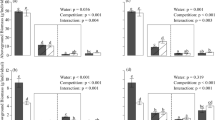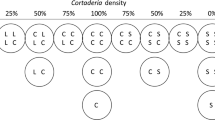Abstract
We explored the roles of phenotypic plasticity and competition in contributing to the success of Eupatorium catarium, a recently invasive noxious annual forb in South China. We compared the growth and functional traits of E. catarium with those of a common native plant, Vernonia cinerea, and a long-term historic invader, Ageratum conyzoides, along a nutrient gradient under both competitive and non-competitive conditions. Under non-competitive conditions, biomass differed little between species under low-nutrient conditions. However, nutrient addition resulted in a greater increase in biomass of the two invasive species than that of V. cinerea. The greater increase in biomass in the two invasive plants may be partly explained by their greater plasticity in specific leaf area. The competition experiments involved different combinations of species: plants of E. catarium were grown with either a plant of A. conyzoides or with a plant of V. cinerea, or individual plants of all three species were grown in competition with a grassland sward grown from 1.5 g seeds of Digitaria radicosa. Relative to non-competitive conditions, competition further increased the biomass difference between the two invasive plants and V. cinerea under high nutrient conditions. A. conyzoides outcompeted E. catarium in terms of biomass production under high nutrient conditions. Overall, these results indicate that A. conyzoides and E. catarium tend to outperform V. cinerea under high nutrient conditions and in both competitive and non-competitive environments. However, E. catarium cannot outperform A. conyzoides in terms of biomass production under each of the nutrient and competitive conditions.





Similar content being viewed by others
References
Blank R (2010) Intraspecific and interspecific pair-wise seedling competition between exotic annual grasses and native perennials: plant-soil relationships. Plant Soil 326:331–343
Blumenthal DM (2006) Interactions between resource availability and enemy release in plant invasion. Ecol Lett 9:887–895
Daehler CC (2003) Performance comparisons of co-occurring native and alien invasive plants: implications for conservation and restoration. Annu Rev Ecol Evol Syst 34:183–211
Davidson AM, Jennions M, Nicotra AB (2011) Do invasive species show higher phenotypic plasticity than native species and if so, is it adaptive? A meta-analysis. Ecol Lett 14:419–431
Dawson W, Fischer M, van Kleunen M (2012a) Common and rare plant species respond differently to fertilisation and competition, whether they are alien or native. Ecol Lett 15:873–880
Dawson W, Rohr RP, van Kleunen M, Fischer M (2012b) Alien plant species with a wider global distribution are better able to capitalize on increased resource availability. New Phytol 194:859–867
Drenovsky RE, Khasanova A, James JJ (2012) Trait convergence and plasticity among native and invasive species in resource-poor environments. Am J Bot 99:629–639
Felsenstein J (1985) Phylogenies and the comparative method. Am Nat 125:1–15
Funk JL (2008) Differences in plasticity between invasive and native plants from a low resource environment. J Ecol 96:1162–1173
Funk JL, Rakovski CS, Macpherson JM (2015) On the analysis of phylogenetically paireddesigns. Ecol Evol 5:940–947
Godoy O, Valladares F, Castro-Díez P (2011) Multispecies comparison reveals that invasive and native plants differ in their traits but not in their plasticity. Funct Ecol 25:1248–1259
Huang QQ, Wu JM, Bai YY, Zhou L, Wang GX (2009) Identifying the most noxious invasive plants in China: role of geographical origin, life form and means of introduction. Biodivers Conserv 18:305–316
Huang QQ, Pan XY, Fan ZW, Peng SL (2015) Stress relief may promote the evolution of greater phenotypic plasticity in exotic invasive species: a hypothesis. Ecol Evol 5:1169–1177
Kan LY, Xie GS, Wang JK (2009) Effect of drought stress on the growth and eco-physiologic characteristics of invasive plant Eupatorium catarium seedlings. Chin J Trop Crops 30:608–612
Li CJ, Yang LF, Yuan K, Wang ZH, Chen QB (2011) RAPD analysis of genetic diversity of different geographic populations of Praxelis clematidea in Hainan. Chin J Trop Crops 32:1523–1526
Li GM, Yuan K, Zou Z, Yang LF, Chen QB, Wang ZH (2012) Invasion of Praxelis clematidea and occurrence of witch’s broom in Hainan. Chin J Trop Agri 32:66–70
Li X, Shen Y, Huang Q, Fan Z, Huang D (2013) Regeneration capacity of small clonal fragments of the invasive Mikania micrantha H.B.K.: effects of burial depth and stolon internode length. PLoS One 8:e84657
Mangla S, Sheley R, James J, Radosevich S (2011) Intra and interspecific competition among invasive and native species during early stages of plant growth. Plant Ecol 212:531–542
Molina-Montenegro M, Peñuelas J, Munné-Bosch S, Sardans J (2012) Higher plasticity in ecophysiological traits enhances the performance and invasion success of Taraxacum officinale (dandelion) in alpine environments. Biol Invasions 14:21–33
Moroney JR, Rundel PW, Sork VL (2013) Phenotypic plasticity and differentiation in fitness-related traits in invasive populations of the Mediterranean forb Centaurea melitensis (Asteraceae). Am J Bot 100:2040–2051
Ordonez A, Olff H (2013) Do alien plant species profit more from high resource supply than natives? A trait-based analysis. Global Ecol Biogeogr 22:648–658
Palacio-López K, Gianoli E (2011) Invasive plants do not display greater phenotypic plasticity than their native or non-invasive counterparts: a meta-analysis. Oikos 120:1393–1401
Powell KI, Knight TM (2009) Effects of nutrient addition and competition on biomass of five Cirsium species (Asteraceae), including a serpentine endemic. Int J Plant Sci 170:918–925
Randall RP (2002) A global compendium of weeds. Richardson, Melbourne
Richards CL, Bossdorf O, Muth NZ, Gurevitch J, Pigliucci M (2006) Jack of all trades, master of some? On the role of phenotypic plasticity in plant invasions. Ecol Lett 9:981–993
Schumacher E, Kueffer C, Edwards P, Dietz H (2009) Influence of light and nutrient conditions on seedling growth of native and invasive trees in the Seychelles. Biol Invasions 11:1941–1954
Shen X, Peng S, Chen B, Pang J, Chen L, Xu H, Hou Y (2011) Do higher resource capture ability and utilization efficiency facilitate the successful invasion of native plants? Biol Invasions 13:869–881
Skálová H, Havlíčková V, Pyšek P (2012) Seedling traits, plasticity and local differentiation as strategies of invasive species of Impatiens in central Europe. Ann Bot 110:1429–1438
Skálová H, Jarošík V, Dvořáčková Š, Pyšek P (2013) Effect of intra- and interspecific competition on the performance of native and invasive species of Impatiens under varying levels of shade and moisture. PLoS One 8:e62842
Ulrich E, Perkins L (2014) Bromus inermis and Elymus canadensis but not Poa pratensis demonstrate strong competitive effects and all benefit from priority. Plant Ecol 215:1269–1275
Valladares F, Sanchez-Gomez D, Zavala MA (2006) Quantitative estimationof phenotypic plasticity: bridging the gap between the evolutionary concept and its ecological applications. J Ecol 94:1103–1116
Van Kleunen M, Dawson W, Schlaepfer D, Jeschke JM, Fischer M (2010a) Are invaders different? A conceptual framework of comparative approaches for assessing determinants of invasiveness. Ecol Lett 13:947–958
Van Kleunen M, Weber E, Fischer M (2010b) A meta-analysis of trait differences between invasive and non-invasive plant species. Ecol Lett 13:235–245
Verlinden M, De Boeck HJ, Nijs I (2014) Climate warming alters competition between two highly invasive alien plant species and dominant native competitors. Weed Res 54:234–244
Weiner J, Damgaard C (2006) Size-asymmetric competition and size-asymmetric growth in a spatially explicit zone-of-influence model of plant competition. Ecol Res 21:707–712
Wilson SB, Wilson PC, Albano JA (2004) Growth and development of the native Ruellia caroliniensis and invasive Ruellia tweediana. HortScience 39:1015–1019
Acknowledgments
We thank the three anonymous reviewers for their constructive comments on the manuscript. The Special Fund for Agro-scientific Research in the Public Interest of China (201403075) and the National Natural Science Foundation of China (31400485) supported this study.
Author information
Authors and Affiliations
Corresponding author
About this article
Cite this article
Huang, Q.Q., Shen, Y.D., Li, X.X. et al. Invasive Eupatorium catarium and Ageratum conyzoides benefit more than does a common native plant from nutrient addition in both competitive and non-competitive environments. Ecol Res 31, 145–152 (2016). https://doi.org/10.1007/s11284-015-1323-x
Received:
Accepted:
Published:
Issue Date:
DOI: https://doi.org/10.1007/s11284-015-1323-x




